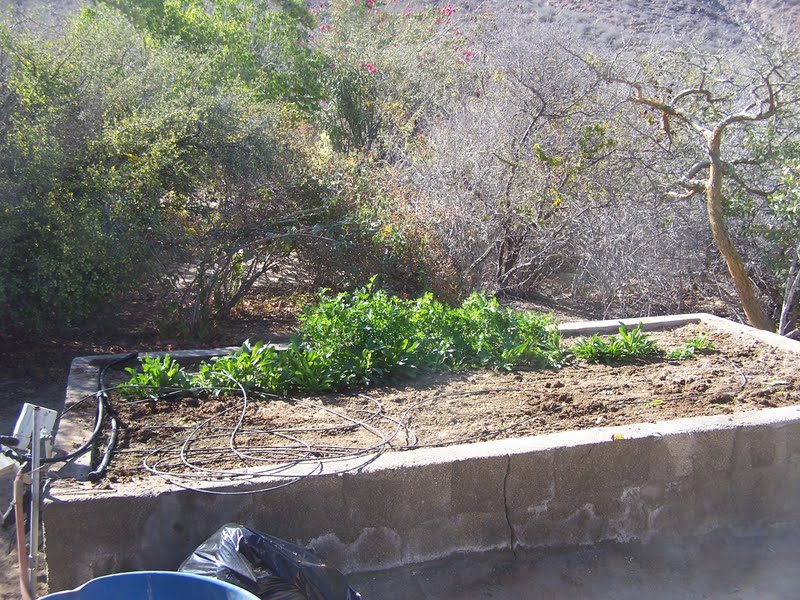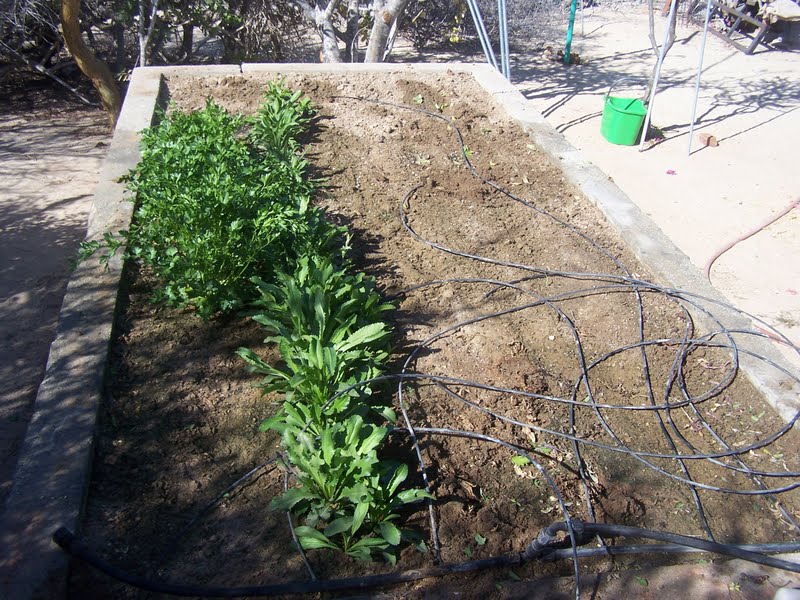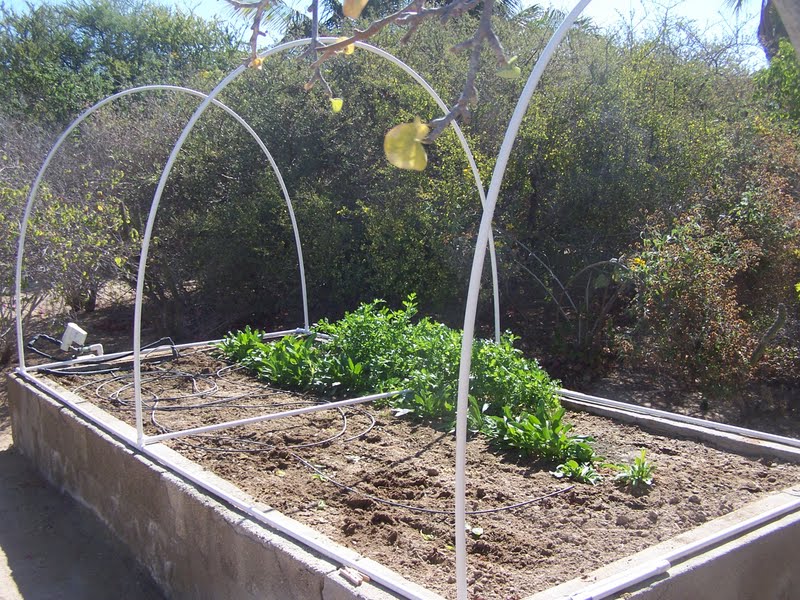We spend the winters in southern Baja in a rather remote area, living off the grid but very well. Our garden is about 7' x 13 ' and is a raised bed garden. We built it about 6 yrs ago and imported dirt from a small cattle ranch nearby and the garden is located less than 200 yards from the Sea of Cortez. Until this year we have had pretty good success with just turning over the dirt to a shovel depth and adding something like Scott's 10-10-10 once per season. I would categorize the soil as good draining, granular in nature, no clay.
We grow some flowers, different varieties of lettuce, tomatos, green beans, carrots, spinach, dill, parsley, cilantro, and so forth. This year we had very poor results and have come to the conclusion that we need to improve our care of the soil.
So I guess I am looking for some suggestions to help us get or soil back in good shape and ready for next falls growing season. We live almost 2 hrs from Cabo or La Paz where some gardening materials are available. We usually like to bring our seeds and specialty stuff down from the US when we return to Baja.
Looking forward to a dialog on this subject. Chipmunks and a racoon have added additional challenges this season. I am making a stouter enclosure/cover for next season. Thanks, Floatflyer
- Floatflyer
- Newly Registered
- Posts: 9
- Joined: Tue Apr 17, 2012 7:01 pm
- Location: Southern Baja
Time to Learn
Last edited by Floatflyer on Wed Apr 18, 2012 11:32 am, edited 1 time in total.
-
GardenGnome
- Greener Thumb
- Posts: 755
- Joined: Sun Jan 29, 2012 6:26 pm
- Location: paradise,ca
Upon reading your description my first thought was WOW access to manure which is an excellent start once again along with tilling or shoveling your dirt deeper and mixing in some compost. I think its mainly a soil depletion as you state and can be fixed without too much expense. Usually I think back and try to remember what made things work the first time.
I have so many times been jealous of those who can access seaweed for their gardens.
https://ventnorpermaculture.wordpress.com/2008/07/16/using-seaweed-in-the-garden/
https://eartheasy.com/blog/2010/09/how-to-use-seaweed-to-mulch-your-garden/
So much free and wonderful resources at your fingertips. Lucky you.....wonderful soil coming your way soon!
https://ventnorpermaculture.wordpress.com/2008/07/16/using-seaweed-in-the-garden/
https://eartheasy.com/blog/2010/09/how-to-use-seaweed-to-mulch-your-garden/
So much free and wonderful resources at your fingertips. Lucky you.....wonderful soil coming your way soon!
- applestar
- Mod
- Posts: 30541
- Joined: Thu May 01, 2008 7:21 pm
- Location: Zone 6, NJ (3/M)4/E ~ 10/M(11/B)
There are many methods, but I use no-till (don't turn over soil and only minimally disrupt the geological and biological strata layers) and no chemical fertilizer or -cides techniques.
The premise is that the soil is a living network of organisms and feeding the soil with organic matter and generally promoting its health grow healthy plants with minimal and sustainable management.
The premise is that the soil is a living network of organisms and feeding the soil with organic matter and generally promoting its health grow healthy plants with minimal and sustainable management.
- Floatflyer
- Newly Registered
- Posts: 9
- Joined: Tue Apr 17, 2012 7:01 pm
- Location: Southern Baja
Ok, I have read and considered all suggestions so far. To recap, I don't believe that salt is a problem as neighbors seem to be doing pretty well and we have in the past. Unfortunately, seaweed (kelp) isn't available in our area or probably in the Sea of Cortez for that matter. I agree that some organic matter needs to be infused into the existing soil.
Now I am interested in this "no till" method, saving labor is important. We have a very small amount of compost available but near by there is a cattle and sheep ranch, free range. Which poop would be the best to use? Would you apply to the soil in the next month and let it sit till October or wait till October to add it? Would one mix this into the soil, to what depth, leave it on top, or ?
All in all this is a subject that will probably generate as many questions for me as answers. Thank you for your patience and advice. FF
Now I am interested in this "no till" method, saving labor is important. We have a very small amount of compost available but near by there is a cattle and sheep ranch, free range. Which poop would be the best to use? Would you apply to the soil in the next month and let it sit till October or wait till October to add it? Would one mix this into the soil, to what depth, leave it on top, or ?
All in all this is a subject that will probably generate as many questions for me as answers. Thank you for your patience and advice. FF
- jal_ut
- Super Green Thumb
- Posts: 7447
- Joined: Sun Jan 18, 2009 10:20 pm
- Location: Northern Utah Zone 5
What I would do is get lots of organic matter on the area in the off season so the microbes will have time to work on it and reduce it to elements the plants can use. Organic matter also greatly improves the tilth of the soil.So I guess I am looking for some suggestions to help us get or soil back in good shape and ready for next falls growing season.
Manure is good if available. Grass clippings are also good to use as mulch all season. I like to till in leaves, grass clippings and manure in the fall and come spring it is ready to grow. Fall and winter are my off season.
Clay seems to be a dirty word in gardening groups, however, clay holds some valuable elements for the plants. It is an overabundance of clay and especially a substrate of dense clay that are problems. 10% clay in your soil is a plus.
I have not joined the "No Till" group, so I will suggest working the organic matter into the soil. The worms will love it.
- Floatflyer
- Newly Registered
- Posts: 9
- Joined: Tue Apr 17, 2012 7:01 pm
- Location: Southern Baja
This starts the specific questions. The pictures show our little garden, today we took down the netting and old posts, pulled out our pitiful tomatos, basil, etc. The laser tubing shown will be replaced next year as it plugs up and doesn't water evenly. We have previously tried 1/4" soaker hose and it too waters unevenly. Thinking about using some irrigation "tape" if that is the correct term, or any other suggestions?
Now as far as putting our bed to bed, so to speak, cow manure is most easily available, this ok? We will NOT be watering the bed this summer. I guess I plan on adding some manure and turning the soil to mix, does this make sense? No grass clippings available here. We are in a virtual desert, most native brush is dry and appears dead as we have been in a prolonged drought for several years, sad. Anything else to consider?
Thanks, Floatflyer


Now as far as putting our bed to bed, so to speak, cow manure is most easily available, this ok? We will NOT be watering the bed this summer. I guess I plan on adding some manure and turning the soil to mix, does this make sense? No grass clippings available here. We are in a virtual desert, most native brush is dry and appears dead as we have been in a prolonged drought for several years, sad. Anything else to consider?
Thanks, Floatflyer
- !potatoes!
- Greener Thumb
- Posts: 1938
- Joined: Tue Apr 14, 2009 2:13 pm
- Location: wnc - zones 6/7 line
if you can turn in the manure, cover the whole bed with extra organic matter, mulch style, and water decently, it'll help keep the whole rig more damp and the microorganisms more able to incorporate the good stuff. any cut organic matter should help - if the bed really dries out, I'd be concerned that the microbial activity could slow down enough that not much progress might happen in your absence.
- Floatflyer
- Newly Registered
- Posts: 9
- Joined: Tue Apr 17, 2012 7:01 pm
- Location: Southern Baja
Ok, we will get some cow manure, that is the easy part. NOW, should we wait till October to add to the garden bed dirt along with some compost and then pretty much start planting within a week or so?
Or, do we try and add manure/compost to the garden bed soil now with maybe a month left that we can water it but then no water for the rest of the summer??
Oh, what to do? Maybe go fishing tomorrow and not worry about it!!
Or, do we try and add manure/compost to the garden bed soil now with maybe a month left that we can water it but then no water for the rest of the summer??
Oh, what to do? Maybe go fishing tomorrow and not worry about it!!
-
greenstubbs
- Senior Member
- Posts: 274
- Joined: Thu Sep 09, 2010 6:41 pm
- Location: Far Upper Alabama
- Floatflyer
- Newly Registered
- Posts: 9
- Joined: Tue Apr 17, 2012 7:01 pm
- Location: Southern Baja
Oblong septic tank???? Wow, first, this septic tank is rectangular, and sceond, it was not designed for an architectural award, but the ability to survive a nuclear blast is something to be proud of.
Now that I know that the appearance is important, here are 2 photos of my new netting support to be installed this coming fall. While this is a completed design, it is not totally glued together so that modifications can be made to enhance the looks.


Now that I know that the appearance is important, here are 2 photos of my new netting support to be installed this coming fall. While this is a completed design, it is not totally glued together so that modifications can be made to enhance the looks.
